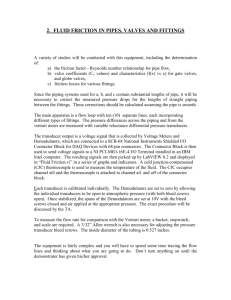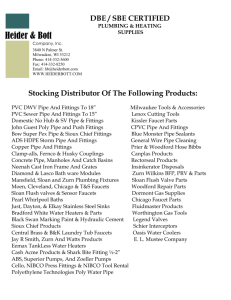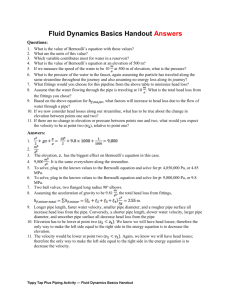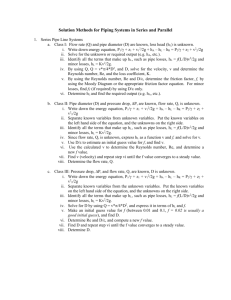Pressure Losses
advertisement
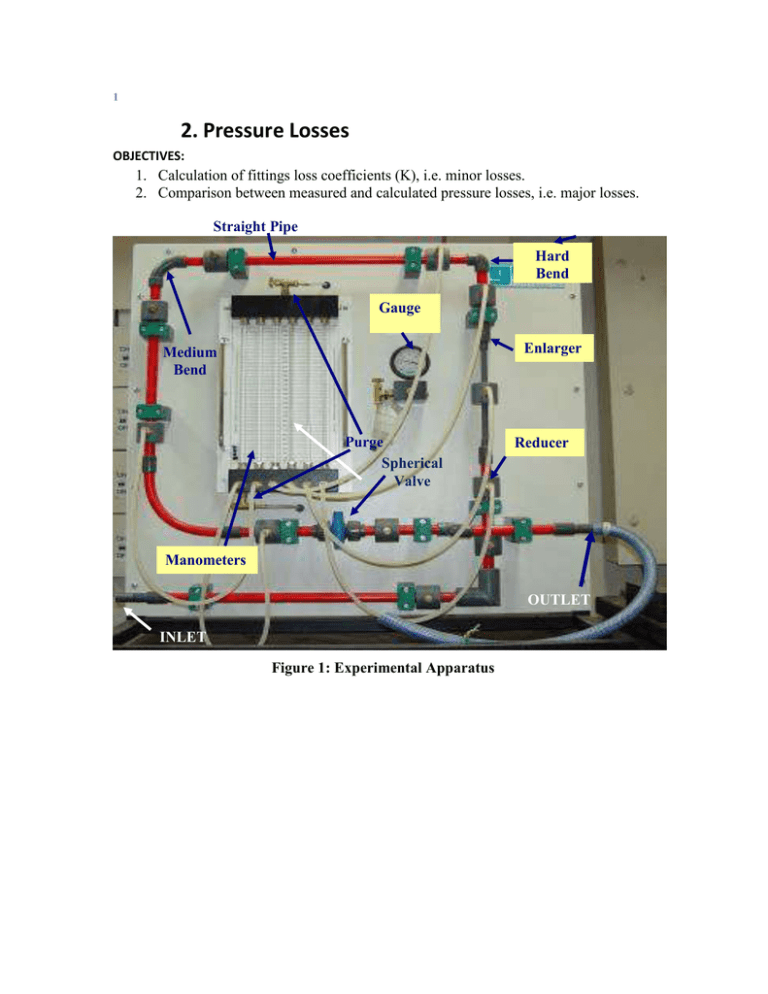
1 2. Pressure Losses OBJECTIVES: 1. Calculation of fittings loss coefficients (K), i.e. minor losses. 2. Comparison between measured and calculated pressure losses, i.e. major losses. Straight Pipe Hard Bend Gauge Enlarger Medium Bend Purge Spherical Valve Reducer Manometers OUTLET PIPE INLET PIPE Figure 1: Experimental Apparatus Water Level Indicator Pump Flow Control Valve Slide Valve Figure 2: Flow Bench and Submersible Pump THE EXPERIMENTAL UNIT: The experimental unit is a comprised from a pipe system with a valve and a number of fittings. The unit also allows for two methods of pressure measurements using 6 manometers and a pressure gauge. The fittings include a number of bends, a reducer, an enlarger, spherical valve and a straight pipe portion. Pressure readings from before and after any section of the system, shown in figure 1, can be measured using the manometers to find the corresponding pressure loss. PROCEDURE: IN THE LAB: 1) De-Airing the Manometers: This is achieved by the opening of both purge valve (upper for air and lower for water) while the flow in the unit is at maximum, i.e. pump and spherical valves both wide open. This will allow any air bubbles in the system and the manometer flexible connectors (should be shaken by hand) to be purged out of the system. 2) Manometers Level Setting: While the pump is on, the spherical valve then the pump valve should be both closed. Then, in a controlled manner, the opening of both purge valves in a way that will bring the level of water in the manometers to the least level possible. This is where water is allowed to flow down out of the manometers through the lower purge and air is allowed to flow down the manometers from the upper purge. This should be done without allowing air to get into the flexible connectors to avoid repeating step 1 above. 3) Obtaining Five or Six Readings: The water level inside manometer with the highest pressure (h1) at the inlet of the reducer (in this case) can easily go out of the range of manometers lengths (despite leveling to the minimum in step 2 above!). Hence, there is only so many different flow rates (or spherical valve openings that can be achieved) here. Therefore, it is necessary to find the maximum flow rate and divide it by the number of steps required. This will help in producing the number of readings required. Here, a 25mm change in h1 manometer level from lowest level is found to give about 5-6 readings. 4) Measure Flow Rates and Manometer Heads: Please fill-in table 1, attached at the end of this sheet. AFTERWARDS: 1. Complete filling-in table 1 (attached). 2. Find ∆P for all fittings/sections including the straight pipe section. 3. Calculate the K factors for all fittings per reading. 4. Draw ∆P versus dynamic head curves per fitting. From this, obtain the average K per fitting. 5. Find the theoretical ∆P for the straight pipe section using the Moody chart. 6. Calculate pipe friction factor and compare to that for a smooth pipe from Moody chart. 7. Discuss your results and the reasons behind their behavior. 8. Compare Moody based friction factor with that obtained by experiment. Provide reasoning for any differences. INTRODUCTION: The Bernoulli Theorem: Born in the 18th century, Bernoulli went to affirm the presence of an energy like equation for fluid flow where the sum of all pressures (static, dynamic and datum) remains constant, in the absence of losses. P V2 Z const. .g 2 g Eqn. 1 This allows to stipulate that: 2 P1 V1 P2 V22 Z1 Z2 .g 2 g .g 2 g Eqn. 2 This is the Bernoulli equation in pressure head form since each of its term has units of (m). 2 P1 V1 P V2 Z1 2 2 Z 2 hL .g 2 g .g 2 g When head losses (∆hL) are involved. Eqn. 3 Bernoulli equation can also be expressed in pressure terms V 2 V 2 P1 1 gZ1 P2 2 gZ 2 ghL 2 2 Elevation Pressure Eqn. 4 Pressure Losses Dynamic Pressure Static Pressure PRESSURE LOSSES: Pressure losses and the knowledge of any coefficients involved in their prediction is very important in fluid mechanics. Such information is critical at the design and development level of new flow systems and in their control. It is also common practice for flow fittings' suppliers to provide the K factors of their fittings among other geometrical data. All pressure losses in flow systems are related to the dynamic pressure within them. There are two main types of pressure losses for the ∆PL term; PL TOTAL (PL ) MAJOR (PL ) MINOR Eqn.5 Major Losses: This is the pressure loss caused by straight pipes. It is called major losses since pipes are usually long (such as in petrol lines) and, hence, cause higher pressure losses. fLV 2 fL V 2 (PL ) MAJOR .g.hL MAJOR .g. 2 gDH DH 2 Eqn. 6 where f is the friction factor obtained from a "Moody diagram" and is a function of the Reynolds number and pipe condition, L is the pipe length and DH is the hydraulic diameter of the pipe section. This formula is used this way in the USA. A slightly different formula is used in the UK. Figure 3: Moody Chart ). D Minor Losses: This type of losses occurs mainly due to changes in velocity, direction or flow area. It is relevant to various fittings that include valves, bends, nozzles, etc… It is calculated as a function of the dynamic pressure multiplied by a factor (K) which is obtained by experiment per fitting type, size and other characteristics. Where f is found from the Moody chart (a function of relative roughness (PL ) MINOR K ( V 2 2 ) Eqn. 7 or V 2 hL K 2g Eqn. 8 V is calculated at the smaller cross-section (where a change in cross-section occurs) and the ∆h direction (or sign) is reversed for the enlarger type of fittings. Manometer Head Readings: can be changed to pressure using the following formula: P .g .h Eqn. 9 2.3 DISCUSSION and ANALYSIS: 1. Discuss the reasons and difference between f values obtained experimentally and analytically using the Moody chart. 2. Compare the results and comment on the reasons for the variation of loss coefficients among fittings. 3. Compare K per fitting to that published in the literature. 4. Find LEquivalent for each fitting using small pipe diameter. ℎ𝑙𝑚 = 𝑓 ̅2 𝐿𝑒 𝑉 𝐷 2 Density= kg/m3 DSMALL= 9.6 mm LSTRAIGHT_PIPE= 415 mm DLARGE= 17 mm Flow Collection Volume Time mL Sec # Manometer Head Readings h1 h2 h3 h4 mm mm mm mm H2 O H2 O H2 O H2 O h5 mm H2 O h6 mm H2 O 1 2 3 4 5 Q # 1 2 3 4 5 L/s Velocity ∆P VSMALL VLARGE Reducer Enlarger Hard Bend m/s m/s Pa Pa Pa K Reducer # 1 2 3 4 5 Enlarger Hard Bend Medium Bend Straight Medium Pipe Bend Pa Pa f Pipe Measured Moody Chart

